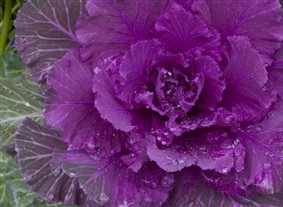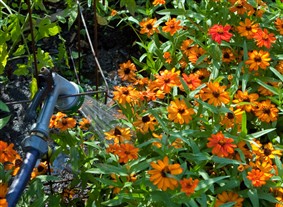What Grows in Chilly Weather?
Views: 6278

I don’t have a fancy English conservatory to grow delightful edibles in all winter long. I don’t even have a lean-to plastic greenhouse to shut out the chilly weather.
Originally, I contemplated building a cold frame from some old farm windows I found for sale on CraigsList, but canceled the opportunity to salvage someone else’s junk when my family wailed in protest. They had visions of another unfinished project taking up space in my garage.
They may be right; the cold frame certainly wouldn’t have been ready for this season. Fall has already brought the first killing frosts to my zone 5 central Ohio garden, and snow is in the forecast. There are a few flowers and vegetables that tolerate light frosts and nippy weather. Here is what is growing in my potager at the end of October.
Chilly Weather Ornamental Cabbage and Kale
Ornamental cabbage and kale are grown for their colorful leaves. You can easily find an abundant selection at garden centers. Curly, lacy leaves brighten fall and winter gardens with shades of red, magenta, green, and white. These ornamental varieties are grown mainly for their landscape value. Nevertheless, they are in the cabbage family and you could eat them if you were so inclined. I planted some in large containers with thyme, sage, and pansies, then plopped one in the center of my four raised beds.
Two of my favorite varieties of kale for the cool season kitchen garden are Red Bor and Black Tuscany. Plant the seeds outside in early spring for early season kale or in late summer for fall and winter salads. These elegant upright varieties love it cool. Red Bor will last all winter in a protected location and then will take the heat of summer making it an excellent annual to fill in voids even in the perennial border.
Swiss Chard for Chilly Weather
Swiss chard is a lovely cool weather edible that looks good even if you don’t eat it. Bright Lights produces a vivid mix of red, yellow, and orange stems and veins that contrast with the deep green leaf. The plants grow to about 18 inches, attractive and delicious planted in mass or in pots. Monstruoso is a variety grown for it’s tender green leaves and crunchy white stems. Cut a few of the outer leaves for stir fries or winter soups.
Beets
Bull’s Blood beets are thriving in the garden now. The leaves of this heirloom variety are great in salads, but the deep red, sweet root is the prize. Tender, baby beets fresh from the garden are one of the joys of growing your own food. Brussels sprouts seem to get sweeter when touched by frost. Harvest the baby cabbage heads when they are about an inch in diameter. Drizzle with olive oil and roast at 400 degrees in the oven until tender.
Parsley
Flat leaf parsley, yellow calendula flowers, and cutting celery are a few of the transitional edibles in the garden. They will turn to mush when the temperature plummets, but they naturally prefer cool weather. If it remains mild these will remain in the garden. With protection, parsley might survive the winter. Periodically, some of my parsley will survive—I let this biennial go to seed the following season; otherwise I treat parsley as an annual, digging up the old on a warm winter day and replanting seedlings in the spring.
Osaka Purple Mustard
Osaka Purple mustard is another favorite cool season vegetable that looks too good to eat, but don’t hesitate. The deep purple pungent leaf is great on a sandwich; a few crisp leaves have the same intense flavor as your best tangy mustard.
Herbs
Many herbs will stay evergreen. Lavender, a good border plant, will turn a soft gray green adding color and texture to the winter garden. Thyme and sage will stay evergreen if protected. I harvest fresh sage for the turkey at Thanksgiving and Christmas.
The cool season kitchen garden has its own subtle beauty and taste. Root and leafy cruciferous vegetables are back on the menu. The kitchen relying on the seasons will be serving parsnips, cabbage, kale, beets, mustard greens, spinach, pak choi, tatsoi, cauliflower, rutabaga, broccoli, broccoli raab, radishes, parsley, and arugula. even without a greenhouse.
Meet Jennifer Bartley
Jennifer Bartley grew up on a ravine near an ancient Indian mound. She remembers spending glorious childhood days picking wildflowers and playing in an old,…
Jennifer's Recent Posts

Hand Watering the Kitchen Garden








